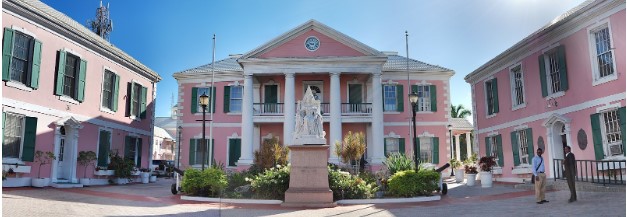- Average Rental Price in The Bahamas: 2024 Guide - April 1, 2024
- 10+ Best Seaplane Tours & Charters in The Bahamas - March 20, 2024
- Old Fort Bay Club: 2024 Luxury Review - March 16, 2024
The Bahamas is best known for its sunny weather, pristine white beaches, and clear, turquoise waters. With its rich history and culture, the warm and friendly locals, and many adventures available, it’s no surprise that this tropical environment is a popular destination for tourists and expats looking to relocate to The Bahamas.
But, there’s so much more to this beautiful Caribbean nation. Let’s look at some interesting facts, statistics, and data about The Bahamas.
Table of Contents
Facts About The Bahamas’ Culture

- The official language of The Bahamas is English, but the local dialect – Bahamianese – is also spoken (source).
- The Bahamas shares a rich history of immigration and emigration with surrounding Caribbean nations and The Americas, creating a truly multicultural population (source).
- The ethnic demography is over 90% African descent, but Bahamian culture stems from African, American, and British influences (source).
- Junkanoo, Goombay, and the Rake ‘n’ Scrape are music and dance styles unique to The Bahamas (source).
- The Bahamas has won 16 Olympic medals in athletics and sailing. This is more medals than any other country with a population under one million (source).
- The Bahamas is a hotspot for the film industry (source). From 20,000 Leagues Under the Sea to Jaws to Pirates of the Caribbean, the islands offer ideal conditions for filming (source). If you’re starstruck, you may want to consider buying a home in Nassau!
Bahamas Geography & Climate

7. Known officially as the Commonwealth of The Bahamas, this vacation destination is its own country located in the Atlantic Ocean. This unique country takes up 97% of the Lucayan Archipelago land of the West Indies and makes up 88% of the archipelago’s population (source).
8. The Andros Barrier Reef, just off Andros Island, is the third largest barrier reef in the world and is over 190 miles long (source).
9. Located in the North American continent, The Bahamas has a very mild climate. The average temperature in The Bahamas in winter is in the low 70s, while the summers bring temperatures in the low 80s. Very rarely do temperatures drop below 60 or above 90 degrees Fahrenheit (source).
10. The Bahamas comprises 700 islands and 2,400 cays, but 670 of these islands are uninhabited (source).
11. The average rainfall in The Bahamas is about 44 inches of rain annually, most of which occurs during summer. Due to prevailing winds coming from the southeast in summer, tropical cyclones and hurricanes threaten from June to November (source).
12. Dean’s Blue Hole, situated on Long Island in The Bahamas, is the deepest blue hole in the entire world. It sits right off the shore and takes a person from knee-deep water to a drop-off of 663 feet. Many world-renown free drivers use this blue hole to attempt world-record dives (source).
13. Mount Alvernia is the highest point in the Bahamas and sits on Cat Island. Following suit with the rest of the country’s islands, it’s a tilted reef standing at a meager 206 feet tall. This highest point is so low compared to other countries that there are only four other countries in the world with a lower highest point recorded (source).

Bahamas History Facts

14. History from this region dates back to 300 to 400 AD. Adventurers from what is now modern-day Cuba came to The Bahamas and survived on its plethora of ocean food (source).
15. The Lucayan people were noted to settle in this country between 900 and 1500 AD. Their culture included peace and political, social, and religious systems that prospered (source).
16. In 1492, Christopher Columbus arrived in this tropical country to find over 40,000 thriving Lucayans. He described it as “baja mar,” which translates to shallow sea. Unfortunately, the Lucayans died out over the next 25 years due to hardship, disease, and slavery from its new visitors (source).
17. In 1649, English Puritans called The Bahamas home. Formally known as the Eleutheran Adventurers, this group ventured to this group of islands in search of religious freedom. In an uncanny food shortage, the settlers received supplies from the Massachusetts Bay Colony. As a thank-you to the Colony, the settlers sent back tons of wood, which the Colony sold and used the funds to buy the land where Harvard University sits today (source).
18. The Bahamas and its vast 700 islands are well noted to be visited by famous pirates throughout the 1600 and 1700s. Records note visits by Calico Jack, Blackbeard, Mary Read, and Anne Bonny. It’s believed that pirate William Catt buried treasure on Cat Island and Sir Henry Morgan buried treasure throughout multiple islands (source).
19. Buried treasure isn’t the only mythical draw on the islands. The Bahamas has its own sea creature similar to the Loch Ness Monster. An extraordinary creature’s carcass washed ashore in 1896 and started the legend of the Lusca. Tales suggest it’s a 75-foot-long half-octopus, half-shark that lives near the blue holes of Andros (source).
20. In 1964, the British government allowed The Bahamas to self-govern. Through a parliamentary democracy, Roland Symonette was the country’s first Premier (source).
Facts About The Bahamas Flag

21. The Commonwealth of the Bahamas flag was adopted on July 10, 1973. It features a horizontal triband, with its top and bottom bands colored aquamarine. The middle band is gold with a black chevron aligned to its left (source).
22. The gold band represents the shining sun and natural resources. The aquamarine bands represent the water surrounding the country. The black chevron symbolizes the strength and force of the Bahamian people across its vast islands (source).
23. Dr. Hervis Bain designed the Bahamian flag as part of a national contest celebrating the country’s independence (source).
24. The flag must always be presented with the black chevron symbol to the left. If the chevron is displayed from the viewer’s right or pointing upwards, it signifies distress (source).
25. The Bahamas flag may be used to drape over a coffin for funeral processions. However, the chevron must sit at the head of the coffin, and the flag itself must be removed before lowering the coffin (source).
Bahamas Economy Statistics

26. The official currency of The Bahamas is the Bahamian dollar, while the U.S. dollar is still commonly accepted throughout the country. The International Organization for Standardization (ISO) code for this currency is BSD, or B$ (source).
27. The Bahamian dollar was first released in 1966, two years after it became self-governing (source). The Central Bank of the Bahamas issues the following banknotes:
-
-
- B$100
- B$50
- B$20
- B$10
- B$5
- B$1
-
28. The gross domestic product (GDP) for The Bahamas, as reported in 2021, was 11.21 billion dollars. Its economy mainly relies on tourism and international financial services. The latter is highly desirable due to its guaranteed secrecy of all financial transactions and no corporate or income taxes (source). In fact, The Bahamas is considered a tax haven.
29. Tourism accounts for over a third of the country’s gross national product (GNP) and employs more than two-fifths of the workforce. It mainly centers around the Grand Bahama islands and Providence (source).
30. The Bahamian dollar is one-to-one with the U.S. dollar (source).
Other Bahamas Statistics

31. According to 2022 estimations, the population of The Bahamas was 355,608 citizens. The country sees a population growth of about .82% annually, and just over 83% of its people live in urban areas (source).
32. The life expectancy at birth is about 76 years, and the working-age population is about 69.22%. The country has 48.82% males and 51.18% females (source).
33. 2021 statistics show that the most significant portion of the population, at 43.56%, is aged 25 to 54. A staggering 21.7% are 0 to 14. Only 9.08% of the population is 65 years of age or older (source).
34. Christianity is widely practiced throughout The Bahamas, and the denominational distribution is Baptists at 34.9%, Anglicans at 13.7%, and Roman Catholics at 12% (source).
35. Analysis of land use reveals that 51% is forest, 28% is water, 1% is agriculture, 3% is urban, and 45% lists as “other.” Source.
36. The largest cities throughout the country include Nassau with 274,000 people; Lucaya with 47,000 people; and Freeport with 40,000 people (source).
Live and Enjoy The Bahamas
Are you inspired to visit – or even move to – The Bahamas? We don’t blame you! The pull of this diverse tropical paradise is strong, and it’s no wonder so many expats call The Bahamas home.
If you already know that you’re ready to make a move and need help finding luxury real estate in The Bahamas, contact us at MCR Bahamas. We can help!

